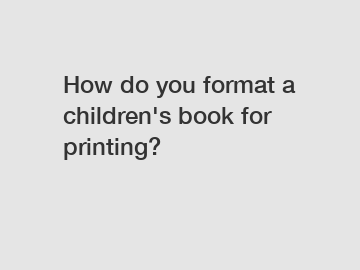How do you format a children's book for printing?
How do you format a children's book for printing?
Children's books are an essential part of a child's development, fostering imagination and a love for reading. If you are an aspiring children's book author, you're likely eager to see your words come to life in print. However, formatting a children's book for printing requires careful attention to detail to ensure the final product is visually appealing and engaging for young readers. So, let's delve into the key aspects of formatting a children's book for printing.
1. Trim size and page count: The first step in formatting a children's book is determining the trim size and page count. Common trim sizes for children's books include 8x8 inches, 8.5x8.5 inches, and 10x8 inches. Choose a size that best showcases your illustrations and caters to the age group you are targeting. Consider the length of your story and the number of illustrations to determine the ideal page count.

2. Layout and design: The layout and design of a children's book play a vital role in captivating young readers. Ensure that each page has a clear hierarchy, with the text placed in an easily readable font and size. Select a font that complements the tone of the story while maintaining readability. Make use of bold and vibrant colors to attract and engage children.
3. Illustrations: An integral part of any children's book, illustrations bring the story to life. When formatting a children's book, it is crucial to consider the placement of illustrations in relation to the text. Avoid cluttering the page with too many illustrations, as it may overwhelm young readers. Allocate ample space for illustrations to shine, allowing the story and visuals to work harmoniously.
4. Bleed and margins: Bleed refers to the area that extends beyond the trim edge of a page. To ensure your illustrations and images appear seamless and professional, it is necessary to include bleed in your file. Generally, a 0.125-inch bleed is recommended. Additionally, pay attention to the inner and outer margins, leaving sufficient space for binding, ensuring no vital elements of the illustrations or text are lost.
5. Font size and type: Since children's books are primarily aimed at young readers, selecting the right font size and type is crucial. Consider using a font that is legible, appealing, and complements the overall design. For large print books, choose a larger font size, while for early readers, opt for clear and easily recognizable fonts. Ensure there is ample spacing between letters, making it easier for children to decode words.
6. Pagination and chapter breaks: Pagination refers to the numbering of pages in a book. While chapter breaks are not as common in children's books, they are still utilized in some cases. Decide whether your book will incorporate pagination and chapter breaks, ensuring consistency throughout the book. Keep in mind that younger readers may find chapter breaks confusing, so use them sparingly, if at all.
7. Proofreading and editing: Before sending your children's book off for printing, it is crucial to proofread and edit meticulously. Check for any grammatical errors, inconsistencies in the storyline, or problems with the layout. Engage a professional editor if necessary, as their expertise can ensure your book is as polished as possible before it reaches young readers' hands.
Formatting a children's book for printing requires attention to detail and a keen eye for design. By considering the trim size, page count, layouts, illustrations, bleed, fonts, pagination, and proofreading, you can create a visually appealing book that engages young readers effectively.
In conclusion, formatting a children's book for printing is a meticulous process that plays a crucial role in enhancing the overall reading experience for children. By paying attention to the key aspects discussed above, you can create a visually stunning book that captivates young readers and fosters a love for literature and storytelling. So, go ahead, apply these formatting tips, and embark on your journey to bring your children's book to life in print.
The company is the world’s best cnprint, cnprint, cnprint supplier. We are your one-stop shop for all needs. Our staff are highly-specialized and will help you find the product you need.


